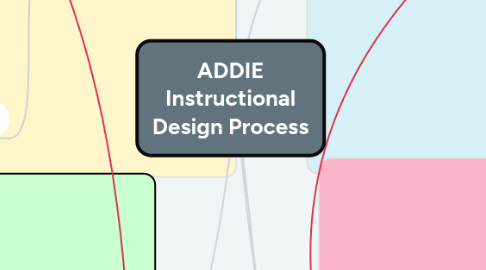
1. 1. Analysis Phase
1.1. Description
1.1.1. Clarification of goals, objectives, and performance gap for target audience
1.2. List of Steps
1.2.1. a. Conduct instructional analysis and document the steps required to perform tasks and/or respond to situations in a way that fulfills the goals
1.2.2. b. Classify the skills and knowledge from the instructional analysis based on Blooms Taxonomy: Knowledge, Comprehension, Application, Analysis, Synthesis, or Evaluation.
1.2.3. c. Document program objectives.
1.2.4. d. Document audience characteristics in terms of existing skills and knowledge, related experience, baseline knowledge, attitudes and behaviors, etc.
1.2.5. e. Review deliverables with client (stakeholders) and incorporate feedback as appropriate.
1.3. Deliverables
1.3.1. Front-End Analysis Report
1.3.2. Instructional Analysis / Needs Assessment
2. 5. Evaluation Phase
2.1. Description
2.1.1. Summative evaluation of the training impact based on Kirkpatrick's evaluation model: learner reaction, learning, behavior, and results.
2.2. List of Steps
2.2.1. a. Create survey instruments and rubrics based on behavior objectives defined in the Analysis Phase.
2.2.2. b. Collect and analyze data, including key performance indicators.
2.2.3. c. Review results with client (stakeholders) and incorporate feedback as appropriate.
2.3. Deliverables
2.3.1. Surveys
2.3.2. Evaluation Report: Findings and Recommendations
3. 4. Implementation Phase
3.1. Description
3.1.1. Delivery of the training and collection of results
3.2. List of Steps
3.2.1. a. Train the instructors and ensure they are familiar with the course materials.
3.2.2. b. Prepare the learners by identifying the tools and knowledge required prior to participating in the course, the materials needed for class, and the specifics of the learning management software, if applicable.
3.2.3. c. Arrange the learning space, test the technology and any multimedia equipment, print out handouts, make sure whiteboards, flips charts, and markers are available.
3.3. Deliverables
3.3.1. Training Implementation Plan
3.3.2. Delivered Training; Course Completion Records
3.3.3. Learner Evaluations
4. Joan Todd Week 2 Assignment Instructional Design Models USMx: LDT200x
5. 2. Design Phase
5.1. Description
5.1.1. Design of the instructional strategy and roadmap for the training course
5.2. List of Steps
5.2.1. a. Translate desired program outcomes into terminal and enabling performance objectives. Given X, the learner will be able to Y.
5.2.2. b. Design the assessment to test that learners have gained the desired skills, knowledge, behaviors, and attitudes after completing the course.
5.2.3. c. Choose the course format (aka Delivery Method) that best facilitates instruction, practice, corrective and confirming feedback, and evaluation, given the resources available.
5.2.4. d. Select Instructional Strategies such as lecture, demonstration, discussion, role-play, project worksheets, hands-on practice, teach-backs, simulations, etc.
5.2.5. e. Review deliverables with client (stakeholders) and incorporate feedback as appropriate.
5.3. Course Map and Design Document
5.4. Deliverables
5.4.1. Training Plan, Style Guides
5.4.2. Evaluation Strategy
6. 3. Development Phase
6.1. Description
6.1.1. Development of training materials based on the approved design.
6.2. List of Steps
6.2.1. a. Create style guides, naming conventions, color palettes, templates, and media formats.
6.2.2. b. Create a sample that shows a representative portion of the training.
6.2.3. c. Organize and develop the course materials based on content gathered from subject matter experts (SMEs) and the Analysis and Design documents. Build in opportunities for confirming and corrective feedback.
6.2.4. d. Review deliverables with client (stakeholders) and incorporate feedback as appropriate.
6.2.5. e. Conduct a "run through" user test with a small group to check logistics, usability, timing, etc. Review results with client/stakeholders and incorporate changes as aappropriate.
6.3. Deliverables
6.3.1. Course Materials
6.3.2. Media (video, audio, animations, graphics, interactive exercises, Self-Study Guides)
6.3.3. Train-the-Trainer Guides
6.3.4. Handouts, Job Aids, Reference Guides
